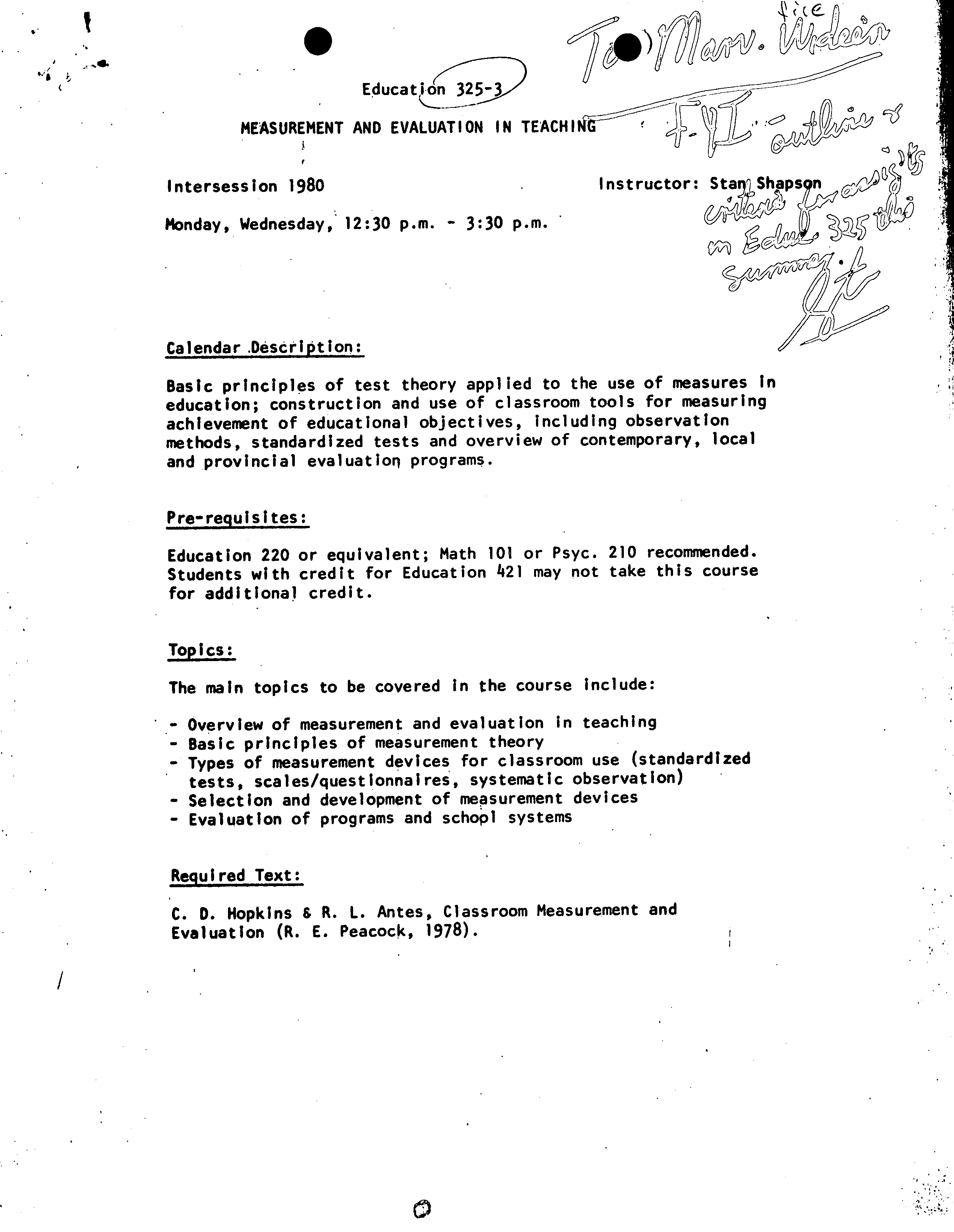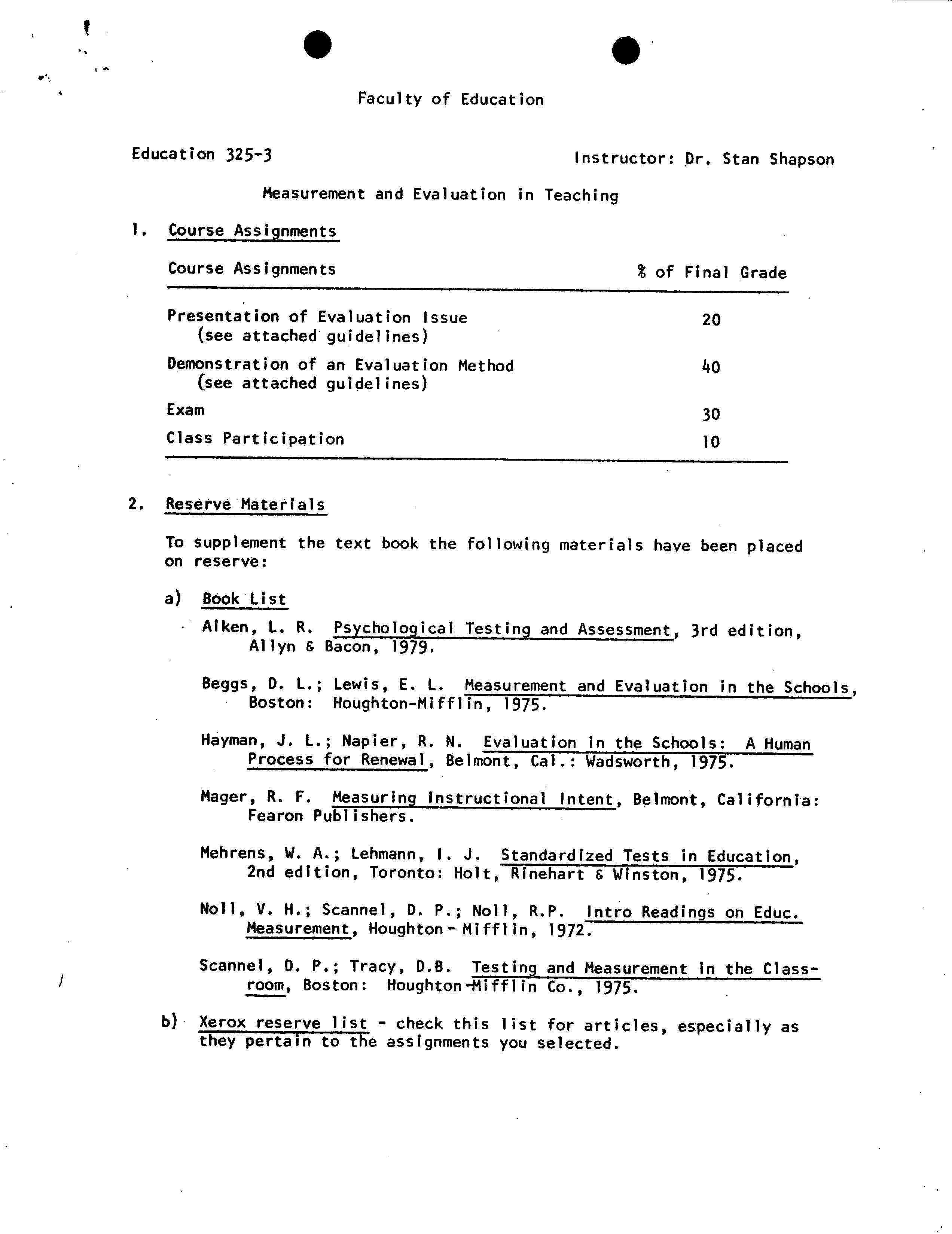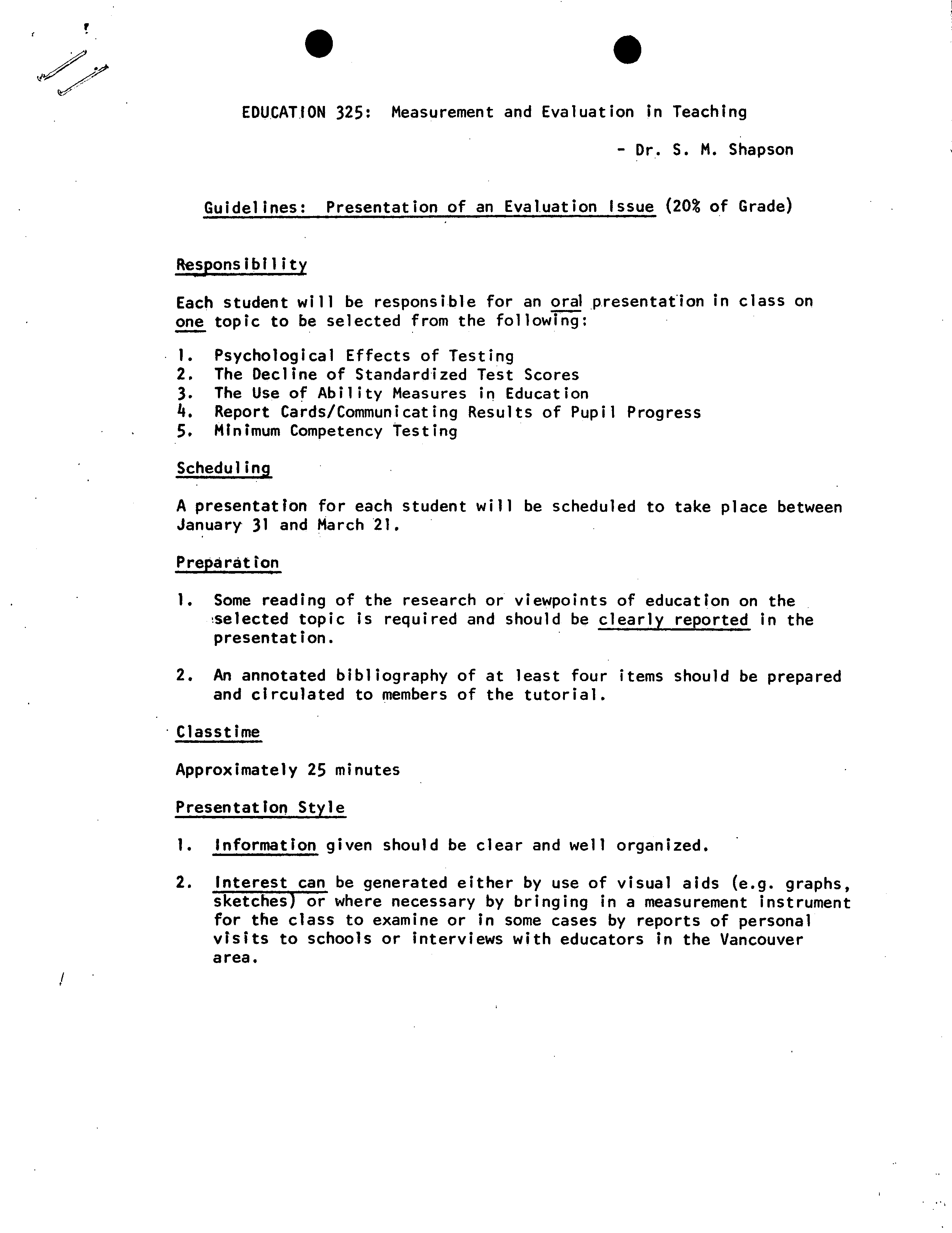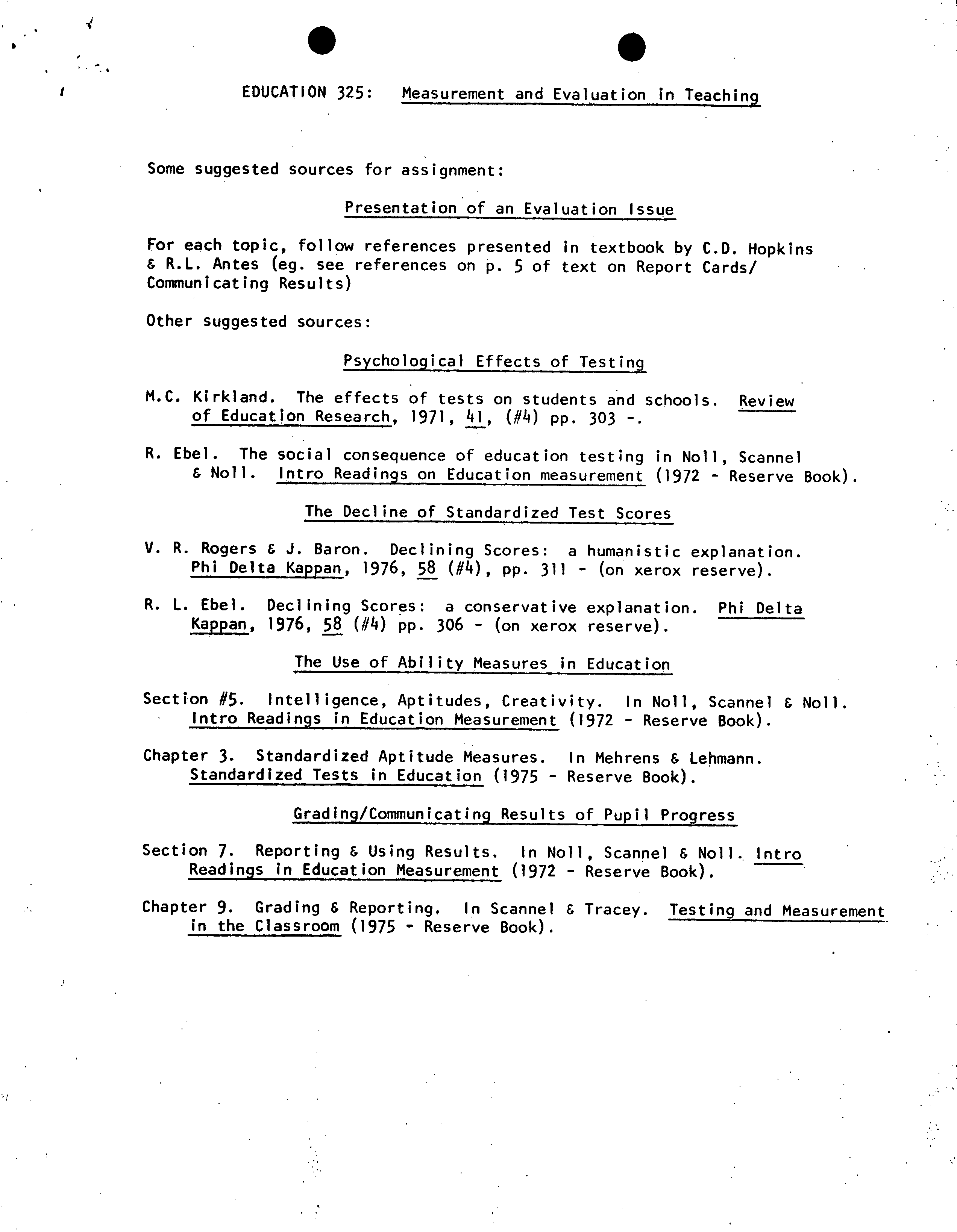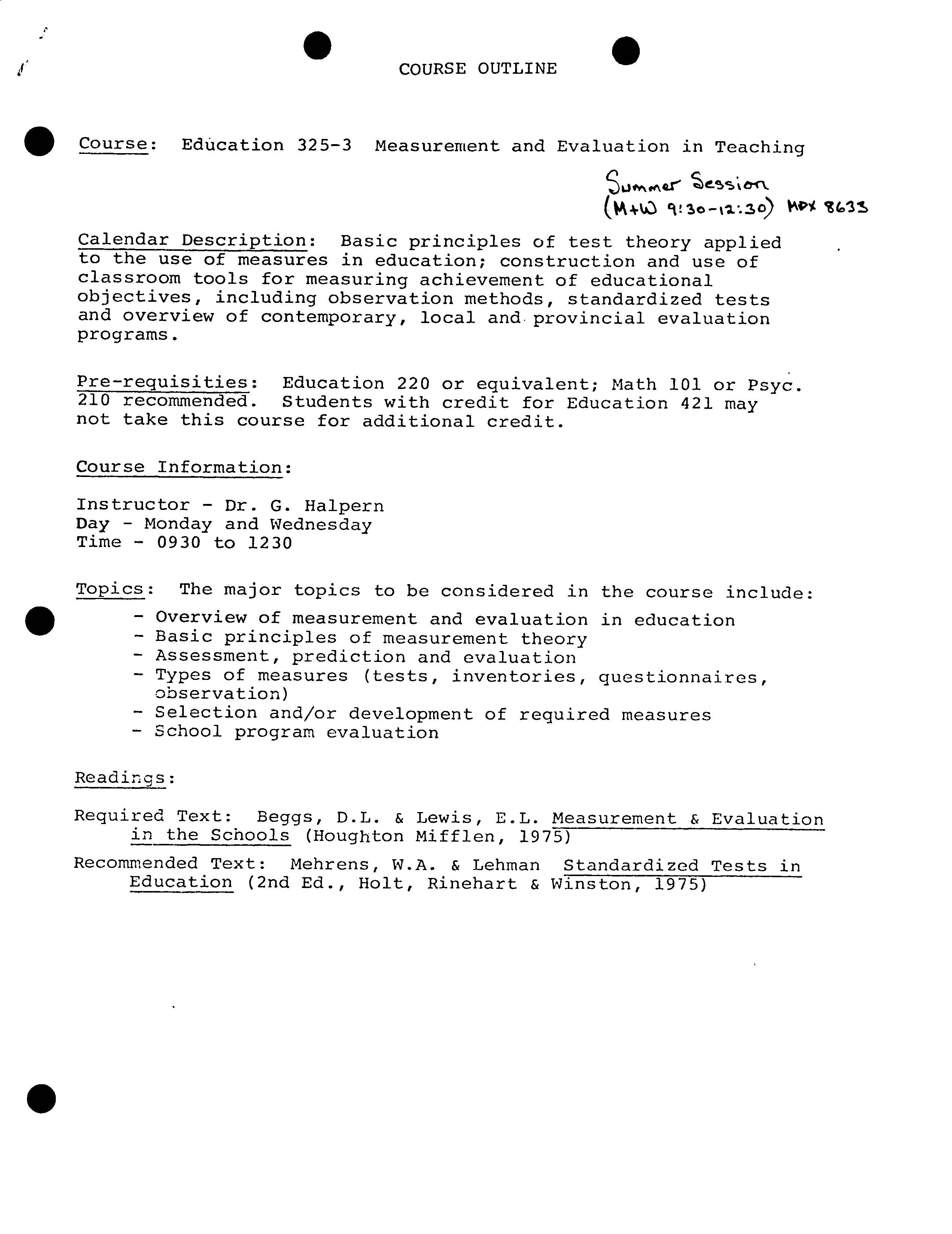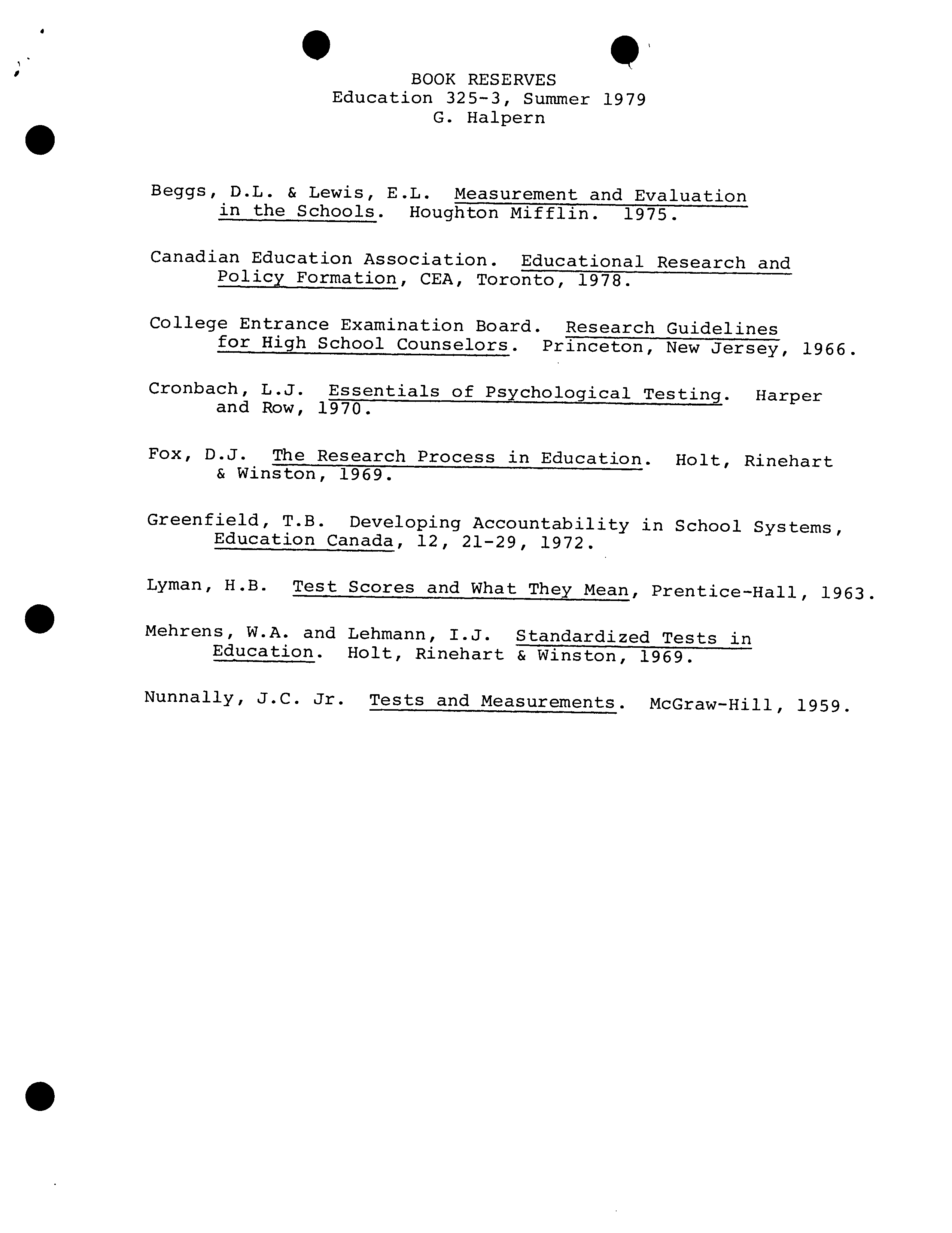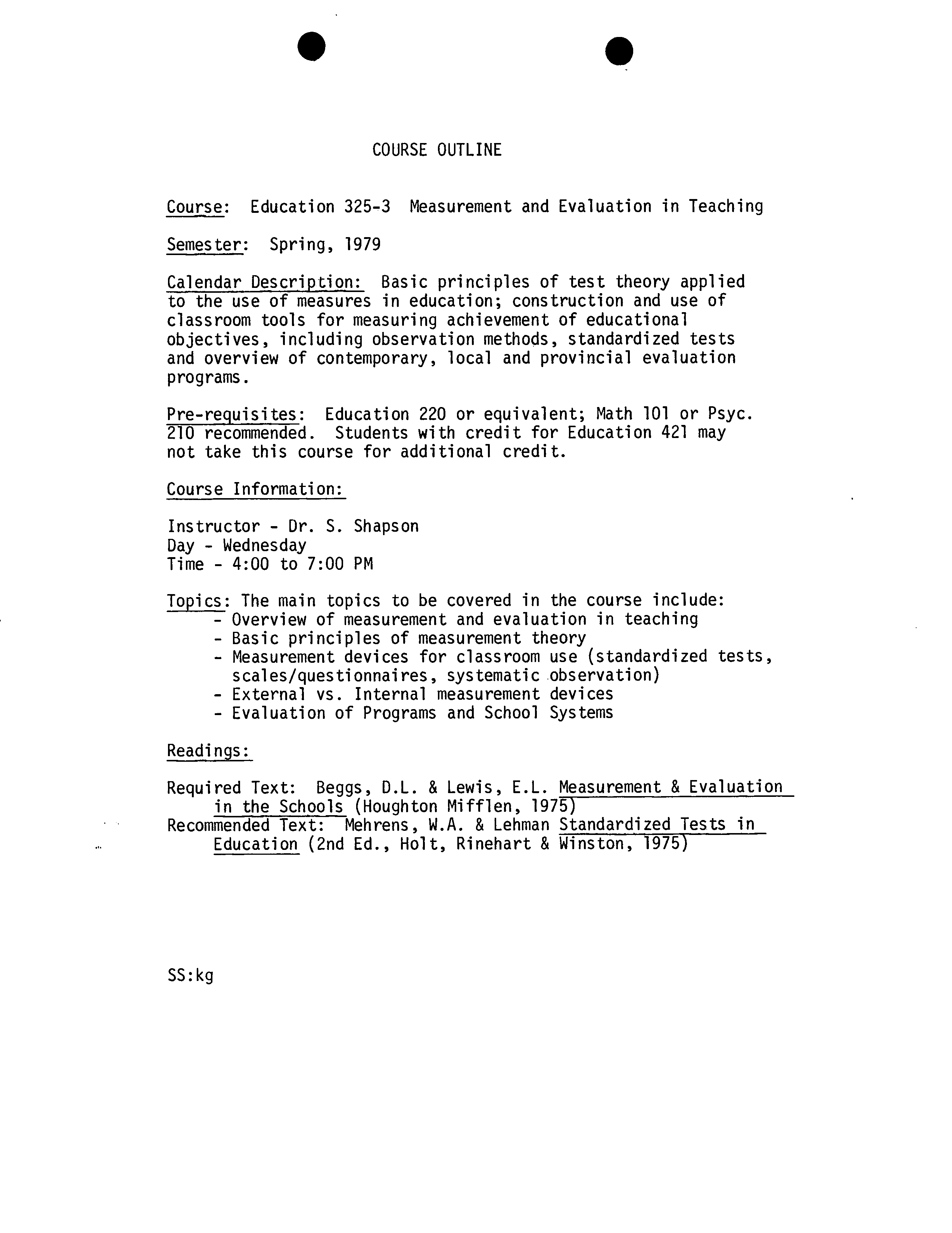.$t7fl) /
UJU
Educa ?
Too
t
)."
MEASUREMENT AND EVALUATION IN TEACH I
Intersession 1980
?
Instructor: StaShapsn
Monday, Wednesday, 12:30 p.m. - 3:30 p.m.
?
lag
Calenda
r
Description:
Basic principles of test theory applied to the use of measures in
education; construction and use of classroom tools for measuring
achievement of educational objectives, Including observation
methods, standardized tests and overview of contemporary, local
and provincial evaluation programs.
Pre-requisites:
Education 220 or equivalent; Math 101 or Psyc. 210 recommended.
Students with credit for Education 421 may not take this course
for additional credit.
Topics:
The main topics to be covered in the course include:
- Overview of measurement and evaluation in teaching
- Basic principles of measurement theory
- Types of measurement devices for classroom use (standardized
tests, scales/questionnaires, systematic observation)
- Selection and development of measurement devices
- Evaluation of programs and schopl systems
Required Text:
C. D. Hopkins & R. L. Antes, Classroom Measurement and
Evaluation (R. E. Peacock, 1978).
S ?
S
Faculty of Education
Education
325-3
?
Instructor: Dr. Stan Shapson
Measurement and Evaluation in Teaching
1.
Course Assignments
Course Assignments ?
* of Final Grade
Presentation of Evaluation Issue
?
20
(see attached' guidel ines)
Demonstration of an Evaluation Method
?
40
(see attached guidelines)
Exam ?
30
Class Participation
?
io
2.
Resérve'Materials
To supplement the text book the following materials have been placed
on reserve:
a)
Book List
Aiken, L. R. Psychological Testing and Assessment, 3rd edition,
Allyn & Bacon,
1979.
Beggs, D. L.; Lewis, E. L. Measurement and Evaluation in the Schools,
Boston: Houghton-Mifflin,
1975.
Hayman, J. 1.; Napier, R. N. Evaluation In the Schools: A Human
Process for Renewal, Belmont, Cal.: Wadsworth,
1975.
Mager, R. F. Measuring Instructional Intent, Belmont, California:
Fearon Publishers.
Mehrens, W. A.; Lehmann, I. J. Standardized Tests in Education,?
2nd edition, Toronto: Holt, Rinehart & Winston,
1975.
Noll, V. H.; Scannel, D. P.; Noll, R.P.
?
Intro Readings on Educ.
Measurement, Houghton- Mifflin,
1972.
Scannel, D. P.; Tracy, D.B. Testing and Measurement in the Class-
room, Boston: Houghton-Mifflin Co.,
1975.
b)
Xerox reserve list - check this list for articles, especially as
they pertain to the assignments you selected.
Cz
EDUCATION 32
?
Measurement and Evaluation beaching
- Dr. S. M. Shapson
Guidelines: Demonstration of an Evaluation Method (40 of Grade)
For this assignment you will be expected to (a) describe and critique
and (b) apply one of the main evaluation methods used to collect data
in education.
The following steps should be followed:
1. Selection of an Evaluation Method
Choose one evaluation method from the following main categories:
(1) systematic observation, (2) standardized tests (achievement
or aptitude), (3) attitudinal scales/questionnaires (for measures
in the affective domain, e.g., attitudes, interests, self-concept).
It. Description/Critique of the Evaluation Method (25)
For the One evaluation method you have selected proceed as
follows:
A. Description
I. Indicate the questions for which this method is generally
used to collect data in education.
2. Outline the procedures generally followed in using this
Evaluation method (i.e., "how" is it used).
B. Critique
3.
Identify the strengths of this evaluation method
4.
Identify the weaknesses of this evaluation method
III; Application of Evaluation Method
(15°')
1.
Identify a question for which you would like to systematically
collect data using this evaluation method.
2.
Select a specific measurement instrument which is representative
of this evaluation method (in the odd case, you may want or need
to develop this instrument).
3.
Administer the instrument to the target audience (Note for
systematic observation, data might be collected from existing
video tapes of classrooms).
4.
Summarize and discuss the results you have obtained as well as
your personal experience using this instrument.
1 ?
SOURCES TO'READ ON THE THREE EVALUATION METHODS:
1.
Follow references cited in textbook
2.
Books on reserve list, eg. Mehrens & Lehmann; Noll, Scannel & Noll;
Scannel & Tracey.
3.
Additions to Xerox reserve list
for Systematic Observation - Medley, "Measuring Classroom Behaviour
by Systematic Observation"
for Scales/Questionnaires - Khan, "The Teaching of Affective Responses"
Bloom "Evaluation Technique for Affective'
Objectives"
. ?
.
EDUCATION 325: Measurement and Evaluation in Teaching
- Dr. S. M. Shapson
Guidelines: Presentation of an Evaluation Issue (20% of Grade)
Re!ponsibility
Each student will be responsible for an oral presentation in class on
one topic to be selected from the following:
1.
Psychological Effects of Testing
2.
The Decline of Standardized Test Scores
3.
The Use of Ability Measures in Education
l
e. Report Cards/Communicating Results of Pupil Progress
5.
Minimum Competency Testing
Scheduling
A presentation for each student will be scheduled to take place between
January 31 and March 21.
Prepa rat ion
1. Some reading of the research or viewpoints of education on the
selected topic is required and should be clearly reported in the
presentation.
2.
An annotated bibliography of at least four items should be prepared
and circulated to members of the tutorial.
Classtfme
Approximately 25 minutes
Presentation Style
1.
Information given should be clear and well organized.
2.
Interest can be generated either by use of visual aids (e.g. graphs,
sketches) or where necessary by bringing in a measurement instrument
for the class to examine or in some cases by reports of personal
visits to schools or interviews with educators in the Vancouver
area.
. ?
.
EDUCATION
325: ?
Measurement and Evaluation in Teachin
g
Some suggested sources for assignment:
Presentation of an Evaluation Issue
For each topic, follow references presented in textbook by C.D. Hopkins
& R.L. Antes (eg. see references on P.
5
of text on Report Cards!
Communicating Results)
Other suggested sources:
Psychological Effects of Testing
M.C. Kirkland. The effects of tests on students and schools. Review
of Education Research,
1971, 41,
04)
pp.
303 -.
R. Ebel. The social consequence of education testing in Noll, Scannel
& Noll. Intro Readings on Education measurement
(1972 -
Reserve Book).
The Decline of Standardized Test Scores
V. R. Rogers
6
J. Baron. Declining Scores: a humanistic explanation.
Phi Delta Kappan,
1976,
58
(
# 1
+),
pp.
311 - (
on xerox reserve).
R. L. Ebel. Declining Scores: a conservative explanation. Phi Delta
Kappan,
1976, 58 (#4)
pp.
306 - (
on xerox reserve).
The Use of Ability Measures in Education
Section
#5. ?
Intelligence, Aptitudes, Creativity.
?
In Noll, Scannel & Noll.
Intro Readings in Education Measurement
(1972 -
Reserve Book).
Chapter 3. Standardized Aptitude Measures. In Mehrens & Lehmann.
Standardized Tests in Education
(1975 -
Reserve Book).
Grading/Communicating Results of Pupil Progress
Section 7. Reporting & Using Results.
?
In Noll, Scannel & Noll. Intro
Readings in Education Measurement
(1972 -
Reserve Book),
Chapter
9.
Grading & Reporting, In Scannel
&
Tracey. Testing and Measurement
in the Classroom
(1975 -
Reserve Book).
.
?
.
I ?
COURSE OUTLINE
Is
Course: Education 325-3 Measurement and Evaluation in Teaching
(IA# ?
co_t.0)
Calendar Description: Basic principles of test theory applied
to the use of measures in education; construction and use of
classroom tools for measuring achievement of educational
objectives, including observation methods, standardized tests
and overview of contemporary, local and. provincial evaluation
programs.
Pre-requisities: Education 220 or equivalent; Math 101 or Psyc.
210 recommended. Students with credit for Education 421 may
not take this course for additional credit.
Course Information:
Instructor - Dr. G. Halpern
Day - Monday and Wednesday
Time - 0930 to 1230
Topics: The major topics to be considered in the course include:
- Overview of measurement and evaluation in education
- Basic principles of measurement theory
- Assessment, prediction and evaluation
- Types of measures (tests, inventories, questionnaires,
observation)
- Selection and/or development of required measures
- School program evaluation
Readings:
Required Text: Beggs, D.L. & Lewis, E.L. Measurement & Evaluation
inthe Schools (Houghton Mifflen, 1975)
Recommended Text: Mehrens, W.A. & Lehman Standardized Tests in
Education (2nd Ed., Holt, Rinehart & Winston, 1975)
I
•
BOOK RESERVES
Education 325-3, Summer 1979?
G. Halpern
Beggs, D.L. & Lewis, E.L. Measurement and Evaluation
?
in the Schools. Houghton Mifflin. 1975.
Canadian Education Association. Educational Research and
Policy Formation, CEA, Toronto, 1978.
College Entrance Examination Board. Research Guidelines
for High School Counselors. Princeton, New Jersey, 1966.
Cronbach, L.J. Essentials of Psychological Testing. Harper
and Row, 1970.
Fox, D.J. The Research Process in Education. Holt, Rinehart
& Winston, 1969.
Greenfield, T.B. Developing Accountability in School Systems,
Education Canada, 12, 21-29, 1972.
Lyman, H.B. Test Scores and What They Mean, Prentice-Hall, 1963.
Mehrens, W.A. and Lehmann, I.J. Standardized Tests in
?
Education. Holt, Rinehart & Winston, 1969.
Nunnally, J.C. Jr. Tests and Measurements. McGraw-Hill, 1959.
0
S
COURSE OUTLINE
Course: Education 325-3 Measurement and Evaluation in Teaching
Semester: Spring, 1979
Calendar Description: Basic principles of test theory applied
to the use of measures in education; construction and use of
classroom tools for measuring achievement of educational
objectives, including observation methods, standardized tests
and overview of contemporary, local and provincial evaluation
programs.
Pre-requisites: Education 220 or equivalent; Math 101 or Psyc.
210 recommended. Students with credit for Education 421 may
not take this course for additional credit.
Course Information:
Instructor - Dr. S. Shapson
Day - Wednesday
Time - 4:00 to 7:00 PM
Topics: The main topics to be covered in the course include:
- Overview of measurement and evaluation in teaching
- Basic principles of measurement theory
- Measurement devices for classroom use (standardized tests,
scales/questionnaires, systematic observation)
- External vs. Internal measurement devices
- Evaluation of Programs and School Systems
Readings:
Required Text: Beggs, D.L. & Lewis, E.L. Measurement & Evaluation
in the Schools (Houghton Mifflen, 1975)
Recommended Text: Mehrens, W.A. & Lehman Standardized Tests in
Education (2nd Ed., Holt, Rinehart & Winston, 1975)
SS: kg
